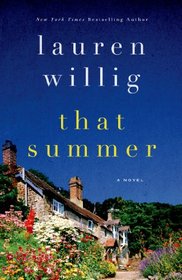Helpful Score: 3
I've been a fan of Gothic novels since I was barely into my teens. For me, it wasn't the romance of the story, but the (often) spooky mansion and the treasures it almost always had tucked away. I must've been in the perfect mood for a return to the Gothic because I fell into That Summer and sank with scarcely a trace.
The old house, Herne Hill, comes up trumps in Willig's story. It's chock-a-block with all sorts of treasures, and when Julia attempts to discover what that big old piece of furniture is hiding, her channeling Nancy Drew and muttering about "the mystery of the old wardrobe" made me laugh. The alternating timelines are also well done. Usually one timeline will be much stronger than the other, but not here. There's too much that needs explanation in Julia's past for it to take a backseat, although I will admit that the 1849 story concerning the always fascinating Pre-Raphaelites does have a tiny bit of an edge.
There are a few stock characters in That Summer; it's hard not to have them in a Gothic novel, but they are limited to a couple of minor characters. The pairs of lovers (or wannabes)-- Imogen and Gavin, Julia and Nicholas-- come close to being perfect. It's fun to read and attempt to deduce the motivations for their behavior. The romance aspect is also very well done: there's enough for romance readers to sigh happily and wish for a little more while not antagonizing those who prefer little-to-no throbbing hearts in their fiction.
Humor, romance, a good brush with creepy characters and situations now and again, secret hiding places, art treasures, and an old house with a story to tell.... If you're in the mood, then I know the book to recommend: Lauren Willig's That Summer.
The old house, Herne Hill, comes up trumps in Willig's story. It's chock-a-block with all sorts of treasures, and when Julia attempts to discover what that big old piece of furniture is hiding, her channeling Nancy Drew and muttering about "the mystery of the old wardrobe" made me laugh. The alternating timelines are also well done. Usually one timeline will be much stronger than the other, but not here. There's too much that needs explanation in Julia's past for it to take a backseat, although I will admit that the 1849 story concerning the always fascinating Pre-Raphaelites does have a tiny bit of an edge.
There are a few stock characters in That Summer; it's hard not to have them in a Gothic novel, but they are limited to a couple of minor characters. The pairs of lovers (or wannabes)-- Imogen and Gavin, Julia and Nicholas-- come close to being perfect. It's fun to read and attempt to deduce the motivations for their behavior. The romance aspect is also very well done: there's enough for romance readers to sigh happily and wish for a little more while not antagonizing those who prefer little-to-no throbbing hearts in their fiction.
Humor, romance, a good brush with creepy characters and situations now and again, secret hiding places, art treasures, and an old house with a story to tell.... If you're in the mood, then I know the book to recommend: Lauren Willig's That Summer.
The dust jacket portrays a beautiful English garden. The synopsis mentions fate. After a slow start caused mainly by the author's use of first and another time last names, with a bevy of artist characters, the tempo escalates to an all night page turner. Unfortunately, the plot goes in a very dark and unexpected direction. Fate does not sink the ship! If you fancy a macabre unresolved cliffhanger, this book may be for you. I'm sorry I read it and I've read all but one of her other books.
That Summer is a dual time track story in which people from 2009 attempt to solve a mystery from the past - 1850. Juliet, our current day heroine, is left an old house just outside London by her aunt. While clearing out the house with a view to sale, she finds a painting by a little known pre Raphaelite painter which intrigues her. She is introduced to Nick, an antiques dealer who can perhaps help her. There is a mystery behind the painting and they set out to solve it. Meanwhile on the other track we learn about the people in the painting and what happened to them. It's a very engrossing story, but I wound up thinking that the people from 1850 seemed much more credible than the ones for 2009. But I recommend it as a good read.




![header=[] body=[Get a free book credit right now by joining the club and listing 5 books you have and are willing to share with other members!] Help icon](/images/question.gif?v=29befa08)
